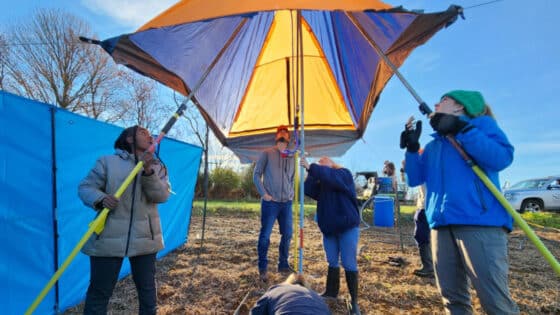Aufdenkampe, A.K., and J.W. Murray. 2002. Deep Sea Research Part II: Topical Studies in Oceanography 49(13–14):2649–2668.
doi: 10.1016/S0967-0645(02)00052-8
Abstract
A coupled nitrogen–iron model is developed from simple mass balance equations to address fundamental controls on new production (NP) and how they relate to nitrate concentrations in high-nitrate-low-chlorophyll environments such as the central and eastern equatorial Pacific. The model demonstrates that a wide range of relationships between NP and mixed-layer nitrate is possible due to partial decoupling of nitrogen and iron cycles in the upper ocean. The shapes and slopes of these relationships are determined by the mode of physical forcing that introduces the most variability to the iron supply for a set of observations. When variability of upwelling fluxes is dominantly determined by changes in nutricline depth over changes in upwelling velocity, NP is a linear function of mixed-layer nitrate; whereas when variability in upwelling velocity dominates, NP takes on a hyperbolic function of nitrate. Fluctuations in atmospheric iron supply also introduce distinct patterns between NP and mixed-layer nitrate concentrations. Variability in nitrogen-to-iron ratios in exported organic matter, however, are not likely to drive large changes in NP or nitrate because of expected covariation with N:Fe ratios in upwelled source waters.
Within surface waters of the equatorial Pacific, variability in physical forcing exists over a wide range of temporal and spatial scales. Tropical instability waves, equatorially trapped internal gravity waves and daily fluctuations in zonal winds all predominantly drive short-term variability in upwelling velocities with minor changes to nutricline depth. El Niño cycles and Kelvin waves produce longer-term variability in nutricline depth with minimal changes in upwelling velocities. Comparisons of observed NP-to-nitrate relationships for individual cruises to the observed modes of physical forcing match model predictions quite well, with Zonal Flux and Flupac serving as end-member examples of these processes. These results support those from statistical studies (Aufdenkampe et al., Deep-Sea Research (2002) 2619–2648, Aufdenkampe et al., Global Biogeochemical Cycles 15 (2002) 101–113), by offering a mechanistic explanation for observations that the relationship between NP and nitrate is more variable between cruises than within cruises.


